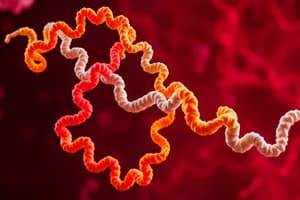Podcast
Questions and Answers
What is the basic unit of structure and function in all living things?
What is the basic unit of structure and function in all living things?
- Organism
- Tissue
- Cell (correct)
- Organ
Which type of cell has genetic material without a nuclear membrane?
Which type of cell has genetic material without a nuclear membrane?
- Prokaryotic cell (correct)
- Unicellular cell
- Multicellular cell
- Eukaryotic cell
What type of organism consists of a single cell performing all body functions?
What type of organism consists of a single cell performing all body functions?
- Eukaryotic organism
- Multicellular organism
- Unicellular organism (correct)
- Prokaryotic organism
Which of the following structures is composed of two or more types of tissues?
Which of the following structures is composed of two or more types of tissues?
Which of the following best defines a group of organs that work together to perform a specific function?
Which of the following best defines a group of organs that work together to perform a specific function?
In multicellular organisms, what process allows cells to perform different functions?
In multicellular organisms, what process allows cells to perform different functions?
Which organ system is responsible for coordinating body activities?
Which organ system is responsible for coordinating body activities?
What do bacteria primarily represent in terms of cellular organization?
What do bacteria primarily represent in terms of cellular organization?
What is the primary function of tissues in an organ?
What is the primary function of tissues in an organ?
Which of the following best describes an organism?
Which of the following best describes an organism?
Flashcards
What is a cell?
What is a cell?
The smallest unit of life; a fundamental building block of all living organisms.
What is a molecule?
What is a molecule?
Two or more atoms joined together by chemical bonds.
What is a tissue?
What is a tissue?
A group of similar cells that work together to perform a specific function.
What is an organ?
What is an organ?
Signup and view all the flashcards
What is an organ system?
What is an organ system?
Signup and view all the flashcards
What is an organism?
What is an organism?
Signup and view all the flashcards
What is a unicellular organism?
What is a unicellular organism?
Signup and view all the flashcards
What is a multicellular organism?
What is a multicellular organism?
Signup and view all the flashcards
What is a prokaryotic cell?
What is a prokaryotic cell?
Signup and view all the flashcards
What is a eukaryotic cell?
What is a eukaryotic cell?
Signup and view all the flashcards
Study Notes
Structure of Living Organisms
- All organisms are composed of atoms.
- Atoms have a nucleus with protons and neutrons, surrounded by electrons.
- Atoms bond to form molecules.
- Molecules combine to create subcellular organelles.
- Cells are the basic structural and functional units of life.
- Tissues are groups of similar cells that perform a specific function.
- Organs are composed of two or more tissues working together for a specific task.
- Examples of organs include the brain, stomach, kidney, and liver.
- Organ systems are groups of organs that work together for a specific function.
- Examples of organ systems include the skeletal, nervous, and reproductive systems.
- Organisms are individual living entities, often composed of multiple organ systems.
Classification of Living Organisms
Cell Classification
- Unicellular: Single-celled organisms (e.g., bacteria) perform all life functions within a single cell.
- Multicellular: Multicellular organisms (e.g., plants and animals) have differentiated cells for various functions.
Nucleus Classification
- Prokaryotic: Cells lack a nucleus; genetic material is not enclosed.
- Eukaryotic: Cells have a nucleus; genetic material is enclosed within the nuclear membrane.
Studying That Suits You
Use AI to generate personalized quizzes and flashcards to suit your learning preferences.




